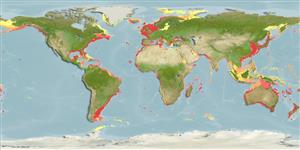Common names from other countries
Classification / Names / Names
Namen | Synonyme | Catalog of Fishes (gen., sp.) | ITIS | CoL | WoRMS
Environment: milieu / climate zone / depth range / distribution range
Ökologie
Pelagisch; brackwasser; tiefenbereich 0 - 200 m (Ref. 1134). Tropical; 3°C - 30°C (Ref. 1134)
Circumglobal except Antarctic.
Length at first maturity / Size / Gewicht / Alter
Maturity: Lm ? range ? - ? cm Max length : 0.2 cm TL Männchen/unbestimmt; (Ref. 1610)
Marine, planktonic; found at depths up to 200 m, with waters temperatures of 3.2 to 29.5°C; rare in the open sea (Ref. 1134). Prefers neritic ambience (Ref. 3531). Found in mangrove vegetate area (Ref. 121475).
Life cycle and mating behavior
Geschlechtsreife | Fortpflanzung | Ablaichen | Eier | Fecundity | Larven
Members of the class Appendicularia are protandrous hermaphrodites. Life cycle: Eggs develop into hatchlings (feeding juveniles) before turning into adults.
Hopcroft, R.R., J.C. Roff and H.A. Bouman. 1998. (Ref. 378)
IUCN Rote Liste Status (Ref. 130435)
CITES Status (Ref. 108899)
Not Evaluated
Not Evaluated
Nutzung durch Menschen
| FishSource |
Tools
Mehr Information
Alter/GrößeWachstumLänge-GewichtLänge-LängeMorphologieLarvenDichte
Internet Quellen
Estimates based on models
Preferred temperature
(Ref.
115969): 6.5 - 25.9, mean 13.6 (based on 2008 cells).
Verwundbarkeit
Low vulnerability (10 of 100).
Preiskategorie
Unknown.
